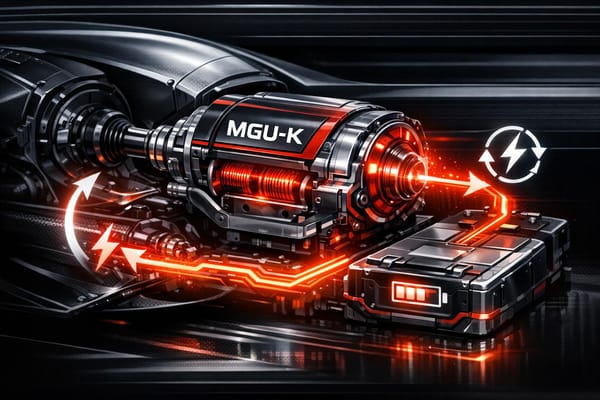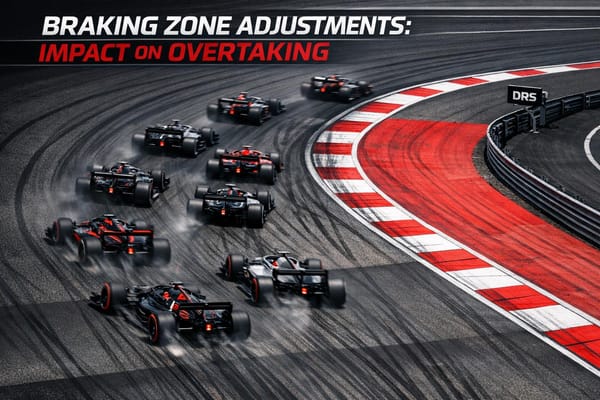How F1 Teams Handle Mid-Race Crises
Explore how F1 teams expertly manage mid-race crises with rapid decision-making, teamwork, and data-driven strategies to stay competitive.

Formula 1 races are unpredictable, and teams must respond quickly to unexpected problems. From mechanical failures to sudden weather changes, every second counts when managing mid-race challenges. Here's how teams handle these situations:
- Mechanical Issues: Teams assess damage through telemetry and driver feedback to decide whether to continue, pit for repairs, or retire the car.
- Weather Changes: Real-time decisions on tire changes (dry, intermediate, or wet) can make or break a race.
- Traffic and Strategy: Monitoring competitors' pit stops and tire conditions helps teams adjust their plans.
- Safety Car or Red Flags: Quick coordination ensures safety and minimizes race impact during on-track incidents.
- Teamwork: Engineers, strategists, and pit crews collaborate under pressure to solve problems and stay competitive.
- Post-Race Reviews: Teams analyze data and incidents to improve future performance.
F1 is all about preparation, quick thinking, and teamwork. These elements help teams turn setbacks into opportunities while staying focused on race-day goals.
INSIDER: How F1 teams manage race disruptions | #IAMSTORIES
First Response: Managing the Opening Critical Seconds
In the high-stakes world of Formula 1, when a crisis unfolds on the track, the first few seconds are crucial. These moments decide whether a situation spirals out of control or is swiftly managed. The response relies on a finely tuned coordination between race control, team personnel, and drivers.
Race Control and Safety Procedures
Race control serves as the nerve center during any mid-race incident. Their job? Evaluate the situation and implement the necessary safety measures. Whether it’s scattered debris or a stranded car, race control acts fast - deploying the safety car or issuing a red flag to ensure the safety of drivers, teams, and track officials.
For example, if debris litters the racing line or a car is in a dangerous spot, the safety car is dispatched without delay. From there, the process is swift but methodical. Track marshals secure the affected area, while electronic boards flash yellow flags or safety car signals to alert everyone on the circuit. Meanwhile, race control keeps teams informed through official communication channels, ensuring everyone is aligned on the procedures in place.
In more severe scenarios, race control may decide to stop the race entirely by deploying a red flag. This decision is made when track conditions become too hazardous to continue. At the same time, teams stay in constant contact with their drivers, guiding their actions and ensuring safety remains the top priority.
Driver Communication and Real-Time Updates
When an incident occurs, the first step for teams is to check in with their driver via dedicated radio channels. The driver’s physical condition is the immediate concern, followed by assessing the car’s state. Depending on the situation, drivers may be instructed to stop safely, return to the pits, or follow safety car protocols. These real-time updates are critical for making informed decisions.
This back-and-forth between driver and team complements telemetry data, providing a clearer picture of the car’s condition. Drivers can describe any damage or irregularities that might not be immediately visible through data alone.
Teams dedicate significant time to training for these high-pressure situations. Quick, clear communication can mean the difference between saving valuable race points or retiring early. Beyond safety, these radio exchanges help teams decide whether the car can still perform competitively or if its performance is too compromised. During safety car periods, this communication is also used to refine strategies, check tire conditions, and plan potential pit stops. In such fast-paced moments, every second counts for both safety and race strategy.
Crisis Evaluation and Decision-Making Process
Once the initial response is underway, teams dive into analyzing multiple data streams to decide the race outcome. This phase builds on the rapid response efforts and focuses on determining the next tactical moves. With only seconds to act, these decisions can mean the difference between earning championship points or retiring from the race. This swift evaluation lays the groundwork for well-coordinated actions in the pit lane.
Telemetry and Live Data Analysis
Modern F1 cars are like mobile data centers, transmitting hundreds of parameters in real time. Telemetry plays a crucial role in diagnosing issues during a crisis. Engineers keep a close eye on metrics like tire temperature, brake wear, engine performance, and aerodynamic efficiency, searching for signs of damage or performance dips. For instance, if sensors detect a sudden drop in oil pressure, unusual tire wear, or irregular brake temperatures, engineers immediately alert the driver and strategists to evaluate the situation and decide whether the problem is short-term or more serious.
In addition to real-time data, teams lean on historical race data and live simulations to predict outcomes. These simulations factor in everything from current track position and competitor strategies to the chances of additional safety car deployments. Armed with this information, engineers can pinpoint problems, estimate lost lap time, and determine whether the car can stay competitive in the race.
Key Decisions: Pit Stops, Repairs, or Race Retirement
This evaluation phase usually leads to one of three choices: pit for repairs, adjust strategy, or retire the car. Each decision depends on a mix of telemetry data, driver feedback, and pit stop inspections. Teams must weigh the severity of the damage, track position, and the likelihood of scoring points. While pit repairs can address certain issues, they come with longer stop times that risk losing valuable race positions. To add complexity, F1’s tire regulations - requiring the use of at least two different tire compounds during a race - force teams to rethink their tire strategy after an unplanned stop.
The hardest call is race retirement. This decision hinges on the extent of mechanical damage, safety risks, and the potential for further harm to the car or driver. If the team opts for retirement, the team principal or race engineer informs the driver via radio, and the team follows FIA protocols to notify race officials. Sometimes, broader championship considerations influence this choice. For example, a heavily damaged car might stay in the race to gather data or in case competitors drop out. On the other hand, a car in championship contention might retire early to protect critical components and avoid worsening the issue.
These decisions, made under immense pressure and often with incomplete information, shape the team’s next steps. Real-time collaboration among race engineers, strategists, and technical directors is essential. Together, they analyze the situation, weigh risks, and reach a consensus, all within seconds.
Team Coordination: Working Together Under Pressure
In the high-stakes world of Formula 1, navigating a race crisis demands seamless teamwork and razor-sharp communication. Every department has a specific role, and their ability to collaborate under pressure often determines the outcome. This collaboration builds on earlier rapid evaluations, ensuring the team operates as a single, synchronized unit to address technical problems without losing competitive momentum.
Communication during crises revolves around a structured hierarchy. The race engineer serves as the central hub, juggling input from telemetry specialists, relaying crucial updates to the driver, and coordinating with the pit crew chief. Meanwhile, the strategy team recalculates race scenarios in real time, offering recommendations that guide critical decisions - whether to pit, stay out, or even retire the car.
Pit Crew Response During Crisis Situations
F1 pit crews are renowned for their speed and precision, regularly completing tire changes in under 2.5 seconds during routine stops. But in a crisis, their skillset is tested even further. When unexpected repairs arise, these crews must pivot from their well-rehearsed routines to quick, effective problem-solving. The moment telemetry data or driver feedback flags an issue, the pit crew chief starts preparing backup equipment, alternate tire compounds, and specialized tools. This preparation ensures the team is ready to adapt on the fly, maintaining their competitive edge.
Crisis pit stops also involve strategic calculations. Teams may employ tactics like undercut or overcut maneuvers to gain track position, adding another layer of complexity to the decision-making process. Balancing urgent repairs with the need to stay competitive requires split-second decisions, while engineering and strategy teams work simultaneously to adjust tactics in real time.
Engineering and Strategy Teams: Live Problem Solving
While the pit crew handles the physical challenges, engineering and strategy teams work behind the scenes to address technical and tactical issues. Using real-time data from sensors and advanced simulation tools, they analyze problems and explore potential solutions. The engineering team focuses on diagnosing faults through telemetry, while the strategy team evaluates how different responses might impact the race outcome. For example, if an unscheduled pit stop is required, strategists quickly determine whether the time lost can be offset by improved tire performance later or if damage control should take priority.
The most intense coordination happens in the narrow window of decision-making. Engineers provide technical insights, strategists assess the competitive landscape, and the race engineer synthesizes this information into actionable decisions. When necessary, team leadership steps in to resolve conflicts or approve critical calls, ensuring a unified response.
To maintain this high level of coordination, teams regularly conduct crisis simulation drills, honing their ability to react swiftly and effectively.
| Team Role | Crisis Response Focus | Tools/Methods |
|---|---|---|
| Pit Crew | Rapid repairs, tire changes | Choreographed drills, equipment |
| Engineering Team | Technical problem-solving | Telemetry, diagnostics |
| Strategy Team | Race plan adjustments, risk analysis | Data analytics, simulations |
| Team Leadership | Decision-making, conflict resolution | Hierarchical communication |
This carefully orchestrated approach allows F1 teams to tackle crises head-on, minimizing delays while finding opportunities to reclaim their competitive standing or gather valuable insights for future races.
Post-Race Review: Learning from Crisis Events
After the checkered flag waves, F1 teams shift gears into a different kind of intensity - post-race reviews. These reviews aren't just about dissecting mistakes; they’re about turning every crisis into an opportunity for growth. By analyzing what went wrong and how it happened, teams prepare themselves to handle future challenges with greater precision.
The process kicks off almost immediately after the race ends. Engineers, strategists, pit crew members, and driver coaches come together for a detailed debrief. Combining technical data with personal observations, they piece together a full picture of each incident. This approach doesn’t just highlight errors - it provides actionable insights that shape future strategies and strengthen the team’s overall resilience.
Incident Analysis and Data Review
Post-race reviews rely on an enormous amount of data - over 1,000 channels per car. Teams use this data, along with other resources like telemetry, onboard cameras, and radio communications, to reconstruct every second of a crisis. Broadcast footage and marshal reports add an external layer of perspective, helping teams determine whether issues stemmed from equipment failures, communication lapses, or strategic miscalculations.
Driver feedback plays a significant role, offering context beyond what the sensors can capture. Advanced tools like ATLAS allow engineers to visualize performance data, compare laps, and test alternative "what-if" scenarios. This level of analysis helps teams uncover patterns and refine their approach for future races.
Updating Crisis Management Procedures
Insights from these reviews directly influence updates to crisis management protocols and training. For example, if a tire failure caused a driver to retire, engineers might simulate different tire management strategies or pit stop timings to see if the outcome could have been avoided. These simulations lead to adjustments in equipment, procedures, and even driver training programs, ensuring the team is better prepared for similar situations in the future.
Key performance indicators (KPIs) like response time, decision accuracy, and incident frequency are tracked closely. By analyzing these metrics alongside race outcomes, teams can measure whether their adjustments are making a measurable difference. Advanced simulation tools and AI-driven analytics are increasingly used to spot patterns and potential weak points that might not be obvious through traditional methods.
For a closer look at how F1 teams refine their strategies after a race, check out expert insights at F1 Briefing. This resource dives into how teams turn setbacks into stepping stones for success.
Conclusion: How F1 Teams Handle Pressure and Bounce Back
Formula 1 teams are masters of navigating high-stakes, mid-race challenges. By combining preparation, teamwork, and quick adaptability, they turn what could be race-ending moments into opportunities to climb the leaderboard - or even secure a win.
Preparation is the cornerstone of success. Long before race day, teams dive into historical data and create contingency plans for every possible scenario. This isn't just about the cars; it’s about the people too. Drivers, engineers, and pit crews are trained to stay sharp and make sound decisions, even when the pressure is at its peak. When stress or fatigue sets in, well-rehearsed protocols help keep everyone focused and effective.
In the heat of the moment, adaptability is what sets the best teams apart. Modern F1 teams lean heavily on data to make split-second decisions - whether it’s switching tire compounds during a sudden downpour or pulling off a flawless pit stop during a safety car period. These precise adjustments often determine whether a team gains or loses crucial positions on the track.
The results speak for themselves. Teams with strong crisis management strategies experience fewer race retirements and recover lost positions faster. For example, analytics show that teams executing perfect pit stops during safety car windows often gain several positions, turning a moment of uncertainty into a tactical advantage.
But it doesn’t stop there. Post-race, teams analyze every detail - technical data and human performance alike - to learn and improve. This commitment to continuous growth ensures they come back stronger for the next race. Their approach to clear communication, flexible strategies, and data-driven decisions offers lessons that extend far beyond the racetrack.
FAQs
What steps do F1 teams take during a mid-race crisis to decide whether to keep racing, pit for repairs, or retire the car?
During a mid-race crisis, F1 teams spring into action, combining real-time data, constant communication, and sharp decision-making to figure out the best path forward. Engineers and strategists dive into telemetry data from the car, analyzing everything from component damage to tire condition and engine performance.
At the same time, they weigh critical factors like the car's position on the track, the number of laps left, and the risks of staying in the race. If repairs are necessary, the team calculates whether the time lost in a pit stop is worth the potential gain. In more serious situations - where safety is at risk or the car is too damaged to continue - they may make the tough call to retire the car, prioritizing the driver's safety and avoiding further harm.
These split-second decisions highlight the incredible precision and expertise that F1 teams bring to every race.
How do F1 teams use telemetry data to address unexpected mechanical problems during a race?
Telemetry data plays a key role in helping F1 teams keep a close eye on a car’s performance and spot mechanical issues as they happen. Sensors installed on the car continuously send critical details - like engine temperature, tire pressure, and fuel levels - straight to the engineers during the race.
If something goes wrong, engineers dive into this data to pinpoint the issue and guide the driver on what to do next. This might involve tweaking car settings or altering driving techniques. By acting quickly, teams can minimize damage and maintain their edge on the track.
How do F1 teams analyze post-race reviews to improve their response to mid-race incidents?
F1 teams dedicate significant effort to post-race reviews, diving deep into every detail to sharpen their strategies for managing mid-race challenges. These reviews typically involve dissecting telemetry data, scrutinizing radio communications, and evaluating the decisions made during the race to spot opportunities for improvement.
By examining how situations like tire blowouts, mechanical failures, or on-track collisions were handled, teams can craft better contingency plans. This also strengthens the collaboration between drivers, engineers, and pit crews. The goal? To be even more prepared for the unexpected in future races.




